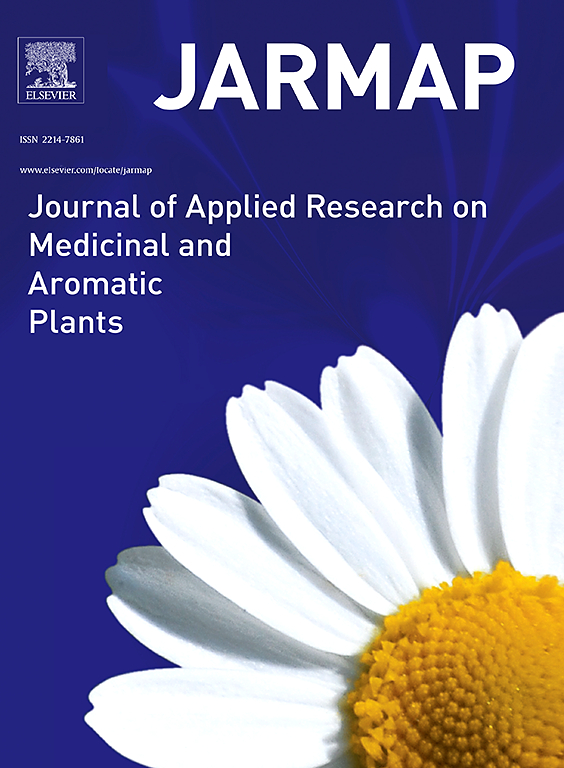Application of gas chromatography-ion mobility spectrometry in traditional Chinese medicines: A review
IF 3.6
2区 农林科学
Q1 PLANT SCIENCES
Journal of Applied Research on Medicinal and Aromatic Plants
Pub Date : 2025-03-04
DOI:10.1016/j.jarmap.2025.100632
引用次数: 0
Abstract
Gas chromatography-ion mobility spectrometry (GC-IMS) has emerged as a powerful analytical technique, renowned for its rapid analysis and operational simplicity, particularly in the detection of trace compounds. While its applications span various scientific domains, its potential in the field of traditional Chinese medicine (TCM) remains relatively underexplored. This review systematically examines the current applications and methodological parameters of GC-IMS in TCM research, with particular emphasis on its transformative potential in quality assessment and authentication processes. The versatility of GC-IMS has been demonstrated across multiple facets of TCM analysis, including (1) differentiation of various Pao Zhi processing techniques and their impact on TCM quality, (2) authentication of TCM specimens through parameters such as storage duration and geographical origin, (3) establishment of robust quality evaluation criteria for TCM formulations, (4) detection and profiling of volatile organic compounds (VOCs) across different growth stages, (5) taxonomic classification of TCM species, and (6) comprehensive characterization of TCM constituents. The integration of GC-IMS in TCM research offers substantial promise for advancing quality control. Its rapid analytical capabilities, coupled with high sensitivity, position it as an indispensable tool for TCM authentication and quality evaluation, with potential applications throughout various stages of TCM production and distribution.
气相色谱离子迁移谱法在中药研究中的应用综述
气相色谱-离子迁移谱法(GC-IMS)已成为一种强大的分析技术,以其快速分析和操作简单而闻名,特别是在痕量化合物的检测方面。虽然它的应用跨越了各个科学领域,但它在中医领域的潜力仍然相对未被充分发掘。本文系统地考察了GC-IMS在中药研究中的应用现状和方法参数,特别强调了其在质量评估和认证过程中的变革潜力。GC-IMS的多功能性已经在中药分析的多个方面得到了证明,包括(1)不同包治工艺的区分及其对中药质量的影响,(2)通过保存时间和地理来源等参数对中药样品进行认证,(3)建立可靠的中药配方质量评价标准,(4)不同生长阶段挥发性有机化合物(VOCs)的检测和分析。(5)中药种类的分类;(6)中药成分的综合表征。GC-IMS在中药研究中的整合为推进质量控制提供了巨大的希望。它的快速分析能力,加上高灵敏度,使其成为中药认证和质量评估不可或缺的工具,在中药生产和销售的各个阶段具有潜在的应用前景。
本文章由计算机程序翻译,如有差异,请以英文原文为准。
求助全文
约1分钟内获得全文
求助全文
来源期刊

Journal of Applied Research on Medicinal and Aromatic Plants
Pharmacology, Toxicology and Pharmaceutics-Drug Discovery
CiteScore
6.40
自引率
7.70%
发文量
80
审稿时长
41 days
期刊介绍:
JARMAP is a peer reviewed and multidisciplinary communication platform, covering all aspects of the raw material supply chain of medicinal and aromatic plants. JARMAP aims to improve production of tailor made commodities by addressing the various requirements of manufacturers of herbal medicines, herbal teas, seasoning herbs, food and feed supplements and cosmetics. JARMAP covers research on genetic resources, breeding, wild-collection, domestication, propagation, cultivation, phytopathology and plant protection, mechanization, conservation, processing, quality assurance, analytics and economics. JARMAP publishes reviews, original research articles and short communications related to research.
 求助内容:
求助内容: 应助结果提醒方式:
应助结果提醒方式:


